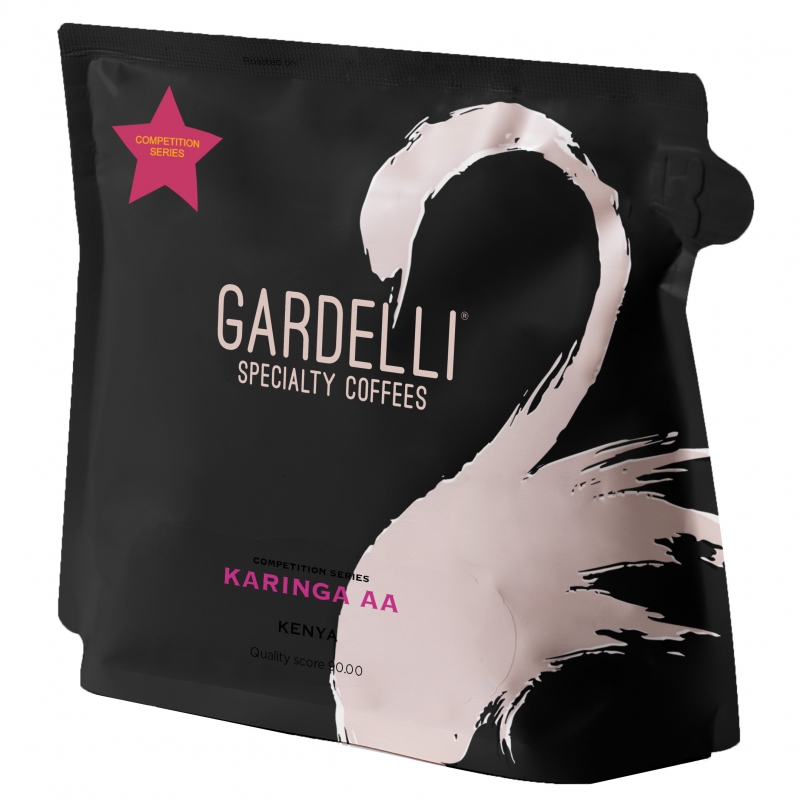Karinga AA – Kenya – Gardelli – Filter and Espresso
Karinga AA – Kenya – Gardelli – Filter and Espresso Founded in 1983, Karinga factory lies on five acres of land serving Kimaruri, Kariungu, Gachuha and Mugalwa villages and sits at an altitude of 1840 masl in the Thika District of Kiambu County, an area traditionally known for tea, and is part of the Gitwe Farmers Co-op which currently has about 500 active members.
Karinga Coffee factory is run by Samwel Muteti, the factory manager. There are six permanent staff members and occasional workers, whose number depends on the crop harvest. Affiliate members of the factory carry out all agronomic activities associated with coffee production (i.e. sourcing coffee from the Coffee Research Station and planting according to its guidelines). Their fieldwork also involves weeding, pruning, spraying, and application of fertilizer, mulching and technical advice offered through farmer training programs and field visits offered by Ministry of Agriculture.
After harvesting, all the coffee is delivered to the factory and undergoes using wet processing method. Water is pumped from River Rwabura to the reservoir tanks for pulping and the water is recycled afterwards. In line with the rising awareness of the need to conserve the environment, the factory has initiated several projects, such as the waste water soak pits, where the water is allowed to soak in back to the soil.
There’s no doubt: Kenya is an amazing coffee destination. Coffees from this origin are known for their powerful rich aromas, refreshing acidity, flavors of sweet berries, and clean and lingering aftertastes.
SL28 was bred by Scott Laboratories in 1931 from Tanganyika D.R, and has become very popular throughout Kenya and is recognised as a variety of exceptional cup quality. It has wide leaves with coppery tips. Beans are wide and productivity comparatively low. Though it is not substantiated that we can find, some sources claim that Scott Labs crossed mutations of French Mission, Mocha and Yemen Typica to produce the SL 28 variety. No matter the exact genetic composition, almost certainly their original goal was to create a plant with high quality, reasonable productivity and great drought resistance.
SL 34 is a mutation of French Mission, originating from the plantation of Loresho in Kabete, SL 34 has wide leaves with bronzy tips. It is widely grown throughout Kenya. SL 34 is valued for its high productivity in different climate conditions and great height ranges. It is also claimed to be resistant towards draught and strong rainfall.
The coffees of Kenya are almost universally processed using a method called ‘double fermentation’, which is a variation of the washed processing method.
It’s used almost exclusively nationwide, and is considered best practice by most farmers.
In the double fermentation processing method, farmers de-pulp the cherries immediately after harvest and place the mucilage coated seeds in fermentation tanks, with minimal water contact, for 12 to 24 hours depending on the rate of fermentation.
The fermentation helps to break down the mucilage making it easier to remove, but also helps to develop the mucilage’s latent fruit character, imparting some of that character into the coffee seed.
In this first stage, the fermentation is allowed to continue until a large portion of the mucilage starts to separate from the seed. The coffee is the flushed from the tanks, into water channels where the agitation helps to rinse and remove the loose mucilage, stopping the fermenting process. Seeds that are low density ‘floaters’ are also scooped off at this stage of the process, one of many steps ensuring the consistent high quality of Kenyan coffee.
After the coffee has been cleaned, step one is repeated, soaking in a secondary fermentation tank for another 12 to 24 hours. This will restart the fermenting process but this time with less sugar and fruit material available. When this second stage is up, the coffee is once again run through water channels where any final residual mucilage is removed.
Once the coffee has been separated, the various lots are moved into their own water tanks where the coffees are soaked for an additional 24 hours. Since the mucilage is has been completely removed, and the coffee is soaking in significantly more water, it’s assumed that enzymatic activity in the coffee increases in this soaking tank, resulting in a strengthening of the amino acids and proteins present in the coffees.
The soaked seeds are then taken out and placed on raised drying beds and spread to a depth of a couple of inches. The idea is to initially dry the coffee rapidly to drop the moisture content and reduce risk. After this initial fast drying period, the coffee is heaped into 6 inch deep mounds and moves into a longer, slower stretch of drying to encourage longer term green quality stably. Time on the raised beds can vary greatly dependant on temperature and weather but the coffee needs to be constantly turned during this period to achieve even drying. Once the moisture of the coffee reaches around 11-12%, this essentially concludes the processing of Kenyan coffee. They are finally dry hulled, graded and prepped for export.



Reviews
There are no reviews yet.